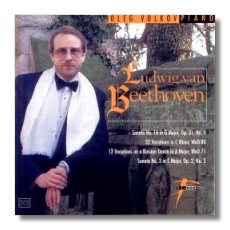
The Internet's Premier Classical Music Source
Related Links
- Beethoven Reviews
- Latest Reviews
- More Reviews
-
By Composer
-
Collections
DVD & Blu-ray
Books
Concert Reviews
Articles/Interviews
Software
Audio
Search Amazon
Recommended Links
Site News
 CD Review
CD Review
Ludwig van Beethoven

Piano Music
- Piano Sonata #16 in G Major, Op. 31, #1
- 32 Variations in C minor, WoO 80
- 12 Variations on a Russian Dance in A Major
from Paul Wranitsky's Ballet "Das Waldmächen", WoO 71 - Sonata #3 in C Major, Op. 2, #3
Oleg Volkov, piano
Produced by Tommie Ewert Carl
Brioso BR115 DDD 73:58
The program on this new Brioso release is an interesting mix of the familiar and the unusual. The sonatas of Beethoven are well represented on recordings. In this case, the artist and producer have gone out of the way to find an unusual item that adds some variety to the program, the Variations on a Russian Dance.
The G Major sonata that opens the program is given a calm and matter-of-fact performance that seems schematic and almost colorless. The pianist is very assured and confident in his handling of the technical difficulties. Here is a cool and nearly literal reading of the piece: Beethoven is allowed to speak for himself. This is in contrast to Richard Goode, who brings warmth and color to this sonata, but his reading is more mannered and his phrasing is more self-conscious. Goode adds pauses in the opening passages that hinder the flow by interfering with the pulse of the music.
In the Adagio, Volkov keeps very steady time and plays with great care but minimal inflection, and the overall effect is pretty but also too careful. The Rondo is not very lively, with as much attention paid to neatness as to energy. The overall impression is of a very conservative performance. The pianist plays well within his abilities and there is no sense of risk and so for the listener no sense of adventure.
This recording is close-up and dry, clear, with little reverberation or ambience. As a result, everything about the performance is very exposed. And why not? This is very accurate playing.
Two sets of variations follow, one relatively familiar and the other much less so. The C minor set has been recorded by Arrau, Gould, Horowitz, Cziffra, Moravec, and Perahia, to name a few. The theme of WoO 80 is very short and bears a slight resemblance to "La Folia." Beethoven gives this little seed a surprisingly wide range of treatments. Perhaps this is not so surprising, as there are few constraints in this simple theme. These variations date from 1806, the year after the "Appassionata" (Sonata #23), and they share some of the brilliance of the more famous work. Volkov gives this work an exciting, passionate reading. Here he does not seem cautious, as before, but neither does he seem to push the limits of his abilities.
WoO 71 was written ten years earlier, at about the same time as the Sonatas of opus 10. The theme isn't Beethoven's. It is taken from PaWranitsky's ballet "Das Waldmädchen," and it is sweet, plain, and square. Of course this means that the variations head in unexpected directions, some oblique, creating many colors and moods. But it is still a slight piece that for all its charms never quite takes flight.
The recording of these variations and of the final sonata has a slightly grainy quality, not as clear as the first half of the disc. These were recorded some years earlier, in Moscow, and were released some years ago on the now-extinct MCA Classics / Art & Electronics label. The quality of the performances justifies the reissue.
With the Sonata #3 (from the first set of sonatas published by Beethoven) the recital really takes off. Volkov throws himself into this performance as though he has something to prove. This is a bravura display, by turns passionate and lyrical. The tempo of the slow movement is especially well judged, and Volkov makes good use of subtle accellerandi for emphasis and to impart a sense of forward movement through tension and release.
Volkov is not a colorist, and it is hard to imagine him playing Debussy. His tonal palette is relatively narrow, like that of Alfred Brendel, and his approach can at times be dry and literal. Volkov's effects come mainly from his fine control of dynamics and tempi, and in Beethoven this is generally sufficient. What is missing in the more recent recordings is a feeling of risk, a sense that the performer is taking some chances and experimenting. Beethoven's scores are so full of possibilities that listeners should expect an adventure, something different and exciting on each new traversal of familiar ground.
Copyright © 1998, Paul Geffen















